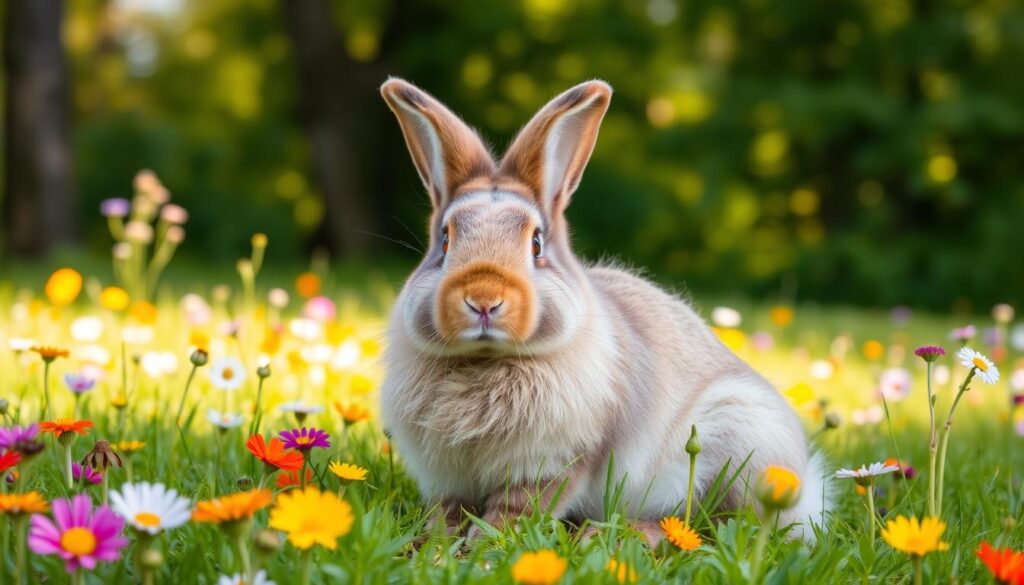Table of Contents
- Understanding Lop Eared Rabbits: A Comprehensive Guide
- Most Popular Lop Eared Rabbit Breeds in America
- French Lop: The Gentle Giant
- Holland Lop: America’s Favorite Compact Companion
- Mini Lop vs. Holland Lop: Understanding the Differences
- Essential Housing Requirements for Lop Eared Rabbits
- Nutrition and Dietary Guidelines
- Health Concerns Specific to Lop Eared Breeds
- Grooming Tips and Maintenance
- Exercise and Enrichment Activities
- Socializing Your Lop Eared Rabbit
- Adopting vs. Buying: Making the Right Choice
- Creating a Rabbit-Proof Home Environment
- Conclusion
- FAQ
Did you know 30% of rabbit owners love lop-eared breeds for their charm? These rabbits have won many hearts in the U.S. with their special looks and kind nature.
Lop-eared rabbits are more than cute. They bring happiness, friendship, and fun to homes. Their unique ears and lively spirit make them a favorite among pet lovers.
This guide will explore lop-eared rabbit breeds, their care, and why they’re great pets. Whether you’re new to rabbits or already a fan, you’ll find useful info here.
Key Takeaways
- Lop-eared rabbits offer unique and adorable pet experiences
- Multiple breeds with distinct characteristics exist
- Proper care is essential for their health and happiness
- These rabbits make excellent companions for various households
- Understanding their specific needs ensures a rewarding pet ownership
Understanding Lop Eared Rabbits: A Comprehensive Guide
Lop-eared rabbits win the hearts of many with their special looks and sweet nature. They have a long history and traits that make them unique among small pets.

Origins and Historical Background
The story of lop-eared rabbits started in Europe in the 19th century. Through careful breeding, they changed from wild rabbits to the pets we love today. Breeders focused on creating rabbits with floppy ears, a trait that makes them special.
- First documented in Belgium and France
- Developed through intentional breeding programs
- Recognized for their distinctive ear characteristics
Distinctive Physical Features
The most noticeable thing about lop-eared rabbits is their ears. Unlike other rabbits, their ears hang down, making them very cute.
| Physical Characteristic | Description |
|---|---|
| Ear Position | Hanging down on both sides of the head |
| Ear Length | Can range from 5-10 inches depending on breed |
| Head Shape | Rounded with soft, gentle features |
Natural Behaviors and Temperament
Lop-eared rabbits are known for being gentle and friendly. They are calm and love to be around people. This makes them great pets for families and individuals.
“Lop-eared rabbits are not just pets, they’re companions with unique personalities and incredible emotional intelligence.” – Rabbit Enthusiast Magazine
Some key behaviors include:
- Highly social and interactive
- Calm and gentle disposition
- Intelligent and trainable
- Enjoy human interaction
Understanding lop-eared rabbit behavior helps create deeper bonds with these lovely animals.
Most Popular Lop Eared Rabbit Breeds in America
The United States loves lop-eared rabbit breeds. These animals have won over many hearts with their floppy ears and sweet personalities.
Several lop-eared rabbit breeds are favorites among American rabbit lovers:
- Holland Lop – A compact and friendly breed
- French Lop – Known for its large size and gentle nature
- Mini Lop – Compact and playful companion
- English Lop – Characterized by extremely long, dramatic ears
- Mini Rex Lop – Soft-furred and affectionate breed
Each lop-eared rabbit breed has its own special traits. Their floppy ears make them stand out from other rabbits.
“Lop-eared rabbits are more than pets; they’re family members with personalities as distinctive as their ears.” – American Rabbit Breeders Association
These breeds are loved for their small size, friendly nature, and cuteness. Whether you’re new to rabbits or have experience, there’s a lop-eared breed for you.
French Lop: The Gentle Giant
The French Lop is a standout in the world of lop-eared rabbits. They are known for their size and gentle nature. These rabbits win the hearts of many rabbit lovers in the United States.
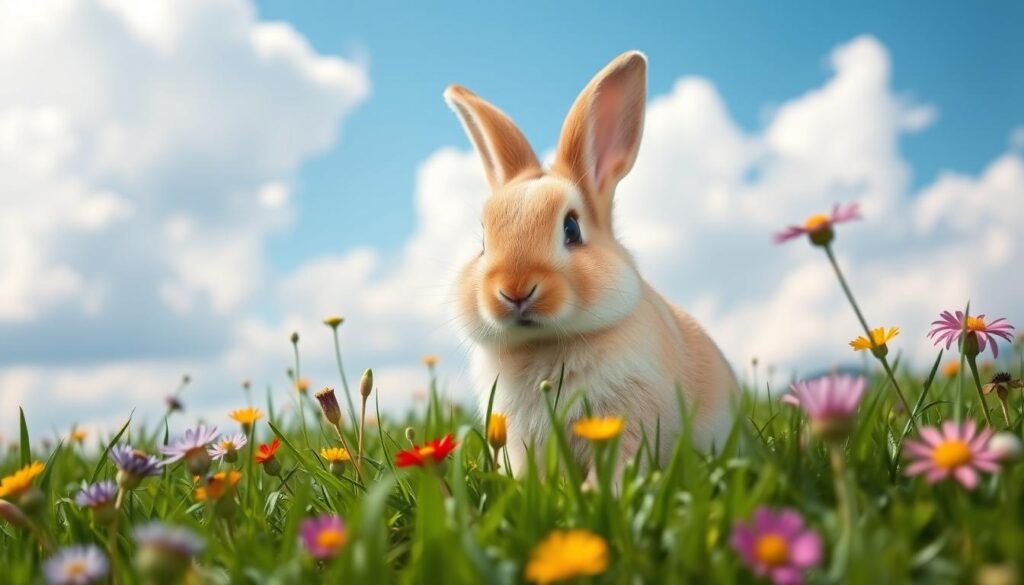
Physical Characteristics
French Lops are the biggest rabbits you’ll find. They weigh between 10-15 pounds. Their long, floppy ears are their most striking feature.
- Average weight: 10-15 pounds
- Ear length: 5-8 inches
- Coat type: Short, dense fur
- Common colors: Solid and broken color patterns
Personality Traits
The French Lop shows off the best of lop-eared rabbit temperament. They are calm and friendly, perfect for families and individuals. Their gentle nature makes them easy to handle and interact with.
“The French Lop is the gentle giant of the rabbit world, combining size with a remarkably sweet temperament.” – Rabbit Breed Experts
Care Requirements
Caring for French Lops requires special attention. They need a lot of space, a balanced diet, and regular vet visits.
| Care Aspect | Specific Needs |
|---|---|
| Housing | Minimum 4×4 foot enclosure |
| Daily Diet | 80% high-quality hay, fresh vegetables, limited pellets |
| Exercise | 2-3 hours of supervised free time daily |
| Grooming | Weekly brushing, regular ear cleaning |
French Lops need dedicated care but offer loving and gentle companionship in return.
Holland Lop: America’s Favorite Compact Companion

The Holland Lop is a favorite among rabbit lovers in the United States. These small rabbits weigh 2-4 pounds. They are great for living in apartments or homes with little space.
Holland Lops are known for their friendly and social nature. They bond well with people and love to play. Their lop ears add to their charm.
“Small in size but big in personality” – Rabbit Breed Association
- Average weight: 2-4 pounds
- Lifespan: 7-12 years
- Color variations: Numerous coat colors
- Ideal for: Families, first-time rabbit owners
| Characteristic | Holland Lop Details |
|---|---|
| Temperament | Gentle, playful, sociable |
| Grooming Needs | Moderate |
| Exercise Requirements | Daily playtime recommended |
Holland Lops are perfect for families looking for a fun and easy pet. With the right care, they become loving and interactive friends.
Mini Lop vs. Holland Lop: Understanding the Differences
Choosing between Mini Lop and Holland Lop rabbit breeds can be tough. These two lop-eared rabbit breeds share some traits but also have their own special qualities. This makes them great pets in their own ways.
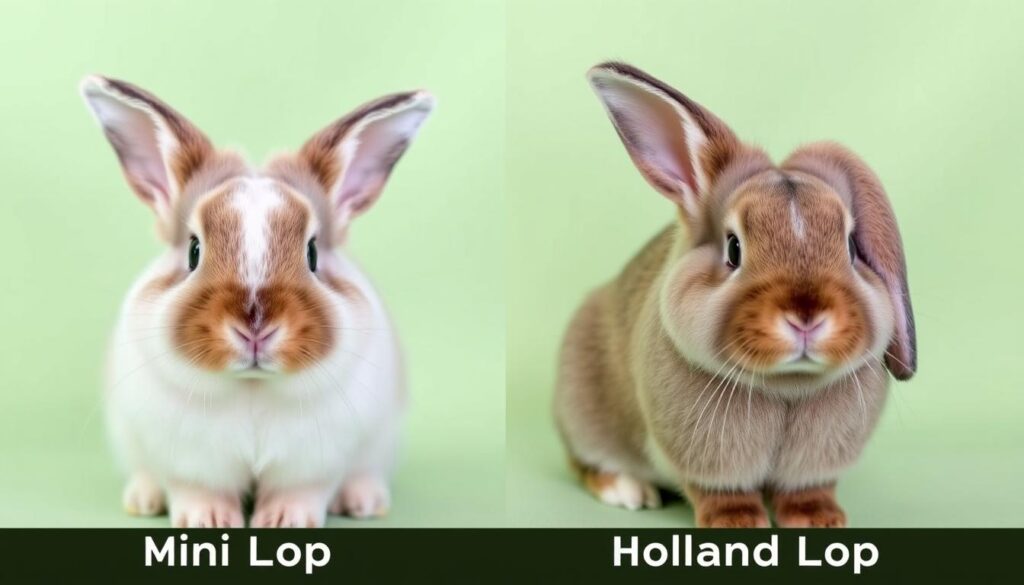
Size Comparisons
Size is key when looking at lop-eared rabbit breeds. Holland Lops usually weigh 2-4 pounds, making them quite small. Mini Lops are a bit bigger, weighing 3-6 pounds.
- Holland Lop: Compact and petite
- Mini Lop: Slightly larger frame
- Weight difference: Approximately 1-2 pounds
Temperament Variations
Understanding each breed’s personality is part of lop-eared rabbit care. Holland Lops are very gentle and great for families. Mini Lops are more lively and fun-loving.
“Every rabbit has its own personality, but breed characteristics can guide your expectations.” – Rabbit Enthusiast Magazine
Care Distinctions
| Care Aspect | Holland Lop | Mini Lop |
|---|---|---|
| Exercise Needs | Moderate | High |
| Grooming Requirements | Weekly brushing | Bi-weekly brushing |
| Space Requirements | Small living spaces | Larger living areas preferred |
Choosing between Mini Lop and Holland Lop depends on your lifestyle and preferences. Both breeds have unique qualities that make them great pets for those who love rabbits.
Essential Housing Requirements for Lop Eared Rabbits
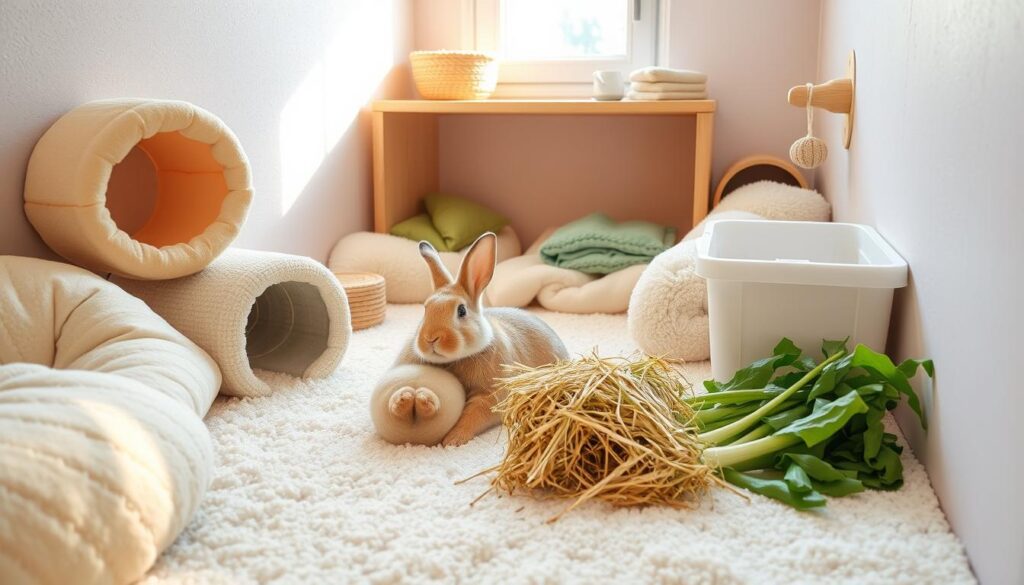
Creating a great home for your lop-eared rabbit needs careful planning. It’s not just about a cage. It’s about making a safe, comfy space that fits their special needs.
When setting up a home for your lop-eared rabbit, remember these key points:
- Minimum cage size of 4-6 square feet for smaller breeds
- Additional exercise area of at least 24 square feet
- Solid-bottom enclosures to protect sensitive feet
- Multiple hiding spots for security
“A rabbit’s home is more than just a cage – it’s their sanctuary.” – Rabbit Care Experts
Here are the must-haves for lop-eared rabbit homes:
- Comfortable bedding (avoid cedar or pine shavings)
- Secure latching mechanisms
- Temperature-controlled environment
- Protection from direct sunlight and drafts
Indoor homes are best for lop-eared rabbits. Wire-bottom cages can cause serious foot injuries. So, choose smooth, easy-to-clean floors. Mix soft bedding with hard surfaces to support their feet and prevent sores.
Good air flow is key in lop-eared rabbit homes. Make sure there’s enough air but keep your pet safe from extreme temps. A quiet, draft-free spot away from loud noises helps your rabbit stay calm and comfy.
Nutrition and Dietary Guidelines
Proper nutrition is key for lop-eared rabbits’ health and happiness. Knowing their dietary needs helps owners care for them well. This supports their long-term wellness.
Daily Food Requirements
A balanced diet for lop-eared rabbits includes several important parts:
- Fresh hay (80% of daily diet): Timothy or orchard grass hay
- Fresh vegetables: 10-15% of diet
- High-quality pellets: Small daily portion
- Unlimited fresh water
Treats and Supplements
Treats are fun, but should be given carefully. Healthy treats for lop-eared rabbits are:
- Small pieces of carrots
- Occasional herb sprigs
- Minimal fruit portions
“Moderation is key when introducing treats to your rabbit’s diet.” – Veterinary Nutrition Experts
Foods to Avoid
Some foods are harmful or toxic to rabbits and should be avoided:
- Chocolate
- Avocado
- Onions
- Processed human foods
- Dairy products
Always consult with a veterinarian specializing in exotic pets to create a personalized nutrition plan for your specific lop-eared rabbit.
Health Concerns Specific to Lop Eared Breeds
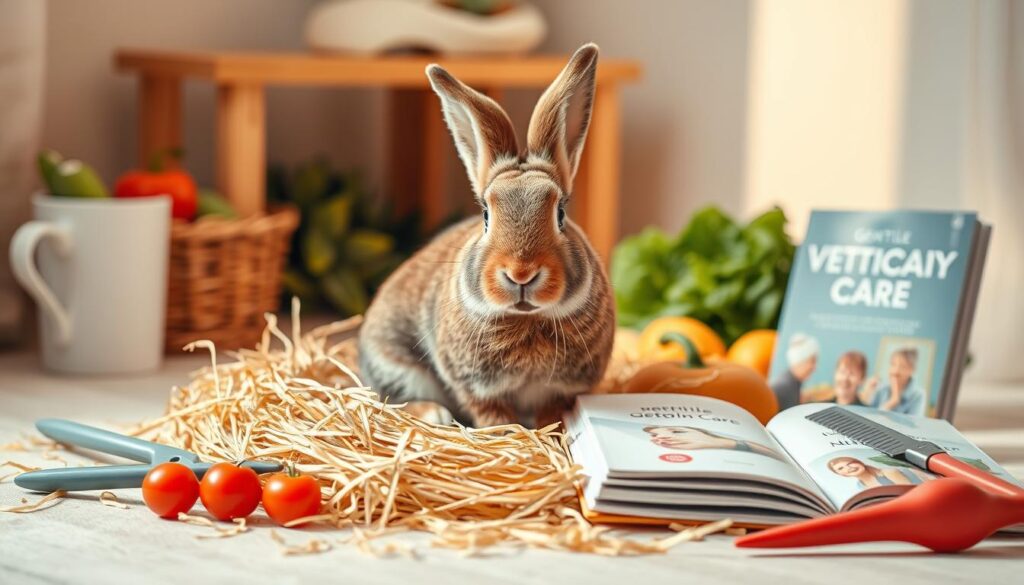
Lop-eared rabbits are charming pets with unique characteristics. But, they face specific health challenges that owners must understand. Their distinctive drooping ears create special health issues that need careful monitoring and proactive care.
The most common health concerns for these adorable companions include:
- Ear infections due to reduced air circulation
- Dental problems related to skull structure
- Increased risk of inner ear complications
- Potential hearing impairments
Ear infections are a big challenge for lop-eared rabbits. Their folded ear structure prevents proper ventilation. This creates a warm, moist environment perfect for bacterial growth. Regular ear cleaning and veterinary check-ups are crucial for prevention.
| Health Concern | Warning Signs | Recommended Action |
|---|---|---|
| Ear Infections | Discharge, redness, head tilting | Immediate veterinary consultation |
| Dental Issues | Difficulty eating, weight loss | Professional dental examination |
| Hearing Problems | Reduced response to sounds | Audiological screening |
“Prevention is always better than cure when managing lop-eared rabbit health issues.” – Veterinary Rabbit Specialists
Preventative care is key to keeping your lop-eared rabbit healthy. Schedule regular vet visits, clean their ears gently, and watch for any unusual behavior. This could mean they have an underlying health problem.
Proper nutrition, clean living environments, and attentive care can significantly reduce the risk of breed-specific health complications.
Grooming Tips and Maintenance
Keeping your lop-eared rabbit clean is key to being a good pet owner. It makes them look great and keeps them healthy.
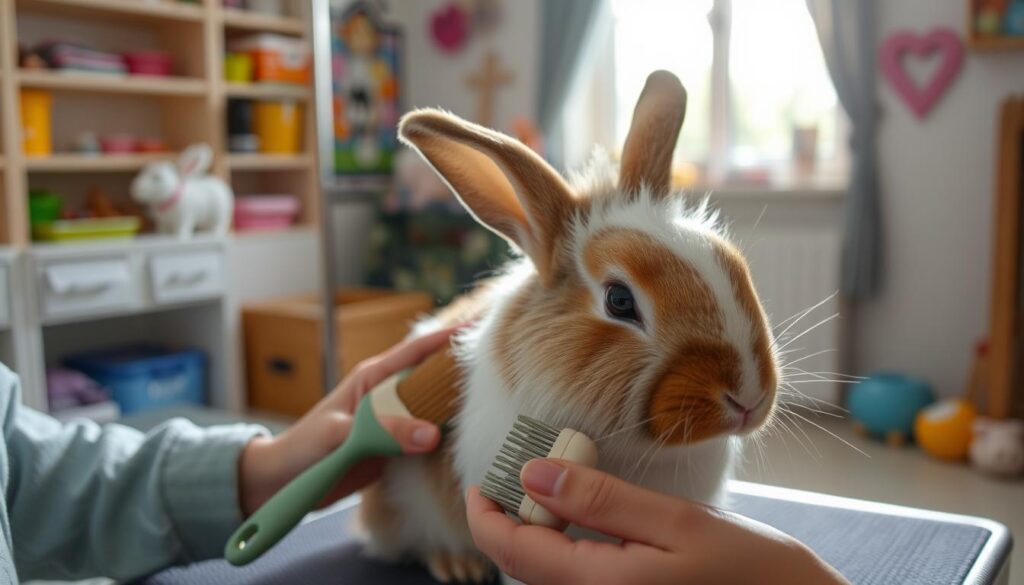
Good grooming for lop-eared rabbits covers many areas. It stops health problems and makes your bond stronger.
Brushing Techniques for Healthy Fur
Brushing is vital for lop-eared rabbits. The right brush depends on their fur:
- Short-haired lops: Brush weekly with a soft-bristled brush
- Long-haired lops: Brush 3-4 times per week to prevent matting
- Use gentle, consistent strokes to remove loose fur
- Pay extra attention to areas prone to tangles
Nail Care Essentials
Trimming nails is crucial for lop-eared rabbits. Here’s how to do it right:
- Check nails every 4-6 weeks
- Use specialized small animal nail clippers
- Trim only the sharp tip, avoiding the quick (pink area)
- Reward your rabbit with a treat after nail trimming
Ear Cleaning Techniques
Lop-eared rabbits are more likely to get ear infections. Clean their ears carefully:
| Cleaning Frequency | Recommended Method | Supplies Needed |
|---|---|---|
| Every 2-4 weeks | Gentle wipe with veterinarian-approved solution | Soft cotton ball, ear cleaner |
| When visibly dirty | Careful external cleaning | Pet-safe ear wipes |
“A clean rabbit is a healthy rabbit. Regular grooming prevents potential health complications and keeps your lop-eared friend comfortable.” – Veterinary Rabbit Care Specialist
By using these grooming tips, your lop-eared rabbit will stay clean and healthy. Always get advice from a vet who knows about rabbits.
Exercise and Enrichment Activities
Keeping your lop-eared rabbit active is key for their health. They need regular exercise and mental challenges. These smart animals need more than just a cage; they need fun activities to keep their minds and bodies sharp.
Exercise is crucial for lop-eared rabbit care. Sitting too much can cause obesity and health problems. It’s important to create a safe play area where your rabbit can explore and move around.
“A happy rabbit is an active rabbit!” – Veterinary Rabbit Specialists
Fun Exercise Activities
- Indoor obstacle courses with tunnels and hiding spaces
- Puzzle feeders that encourage mental stimulation
- Supervised free-roam time in a rabbit-proofed room
- Interactive toys that promote natural foraging behaviors
When planning exercise, think about your rabbit’s personality and abilities. Some lop-eared rabbits may be more playful than others. Watch and adjust activities to fit their needs.
Daily Exercise Recommendations
- Minimum 3-4 hours of out-of-cage time
- 20-30 minutes of structured play
- Rotate toys to maintain interest
- Provide climbing structures and exploration zones
Always watch your rabbit during playtime to keep them safe. Lop-eared rabbit care means creating a fun, safe space for them to be active and explore.
Socializing Your Lop Eared Rabbit
Lop-eared rabbits are social and need careful socialization. Understanding their behavior helps build strong bonds with humans and other pets.
Building Trust with Your Rabbit
Start by creating a safe space for your rabbit. They like calm, consistent interactions that respect their nature.
- Approach slowly and quietly
- Use soft speaking tones
- Allow the rabbit to come to you
- Offer gentle pets on the head and back
Introducing Your Rabbit to Other Pets
Introducing lop-eared rabbits to other pets is delicate. Supervise and introduce them slowly for best results.
| Pet Type | Socialization Difficulty | Recommended Approach |
|---|---|---|
| Cats | Moderate | Supervised, controlled interactions |
| Dogs | High | Gradual, calm introductions |
| Other Rabbits | Low | Neutral territory meetings |
“Patience is the most important ingredient in rabbit socialization.” – Rabbit Behavior Expert
Every rabbit is different. Some are shy, while others are very social. Always watch their body language and respect their comfort.
Adopting vs. Buying: Making the Right Choice
Deciding between adopting a lop-eared rabbit or buying from a breeder is a big choice. Each option has its own benefits. Knowing the differences can help you choose what’s best for you and your lifestyle.
Adoption Advantages
- Rescue a rabbit in need of a loving home
- Lower cost compared to purchasing from a breeder
- Often includes initial veterinary care
- Support local animal welfare organizations
Adopting a lop-eared rabbit gives a second chance to a rabbit in need. Shelters have many lop-eared breeds, making it easy to find the right one for you.
Breeder Purchase Benefits
| Aspect | Breeder Advantage |
|---|---|
| Health Guarantee | Documented genetic history and health screenings |
| Breed Specificity | Select exact lop-eared rabbit breed desired |
| Early Socialization | Puppies raised with professional care |
“The right rabbit is not about where you get them, but the love you provide.” – Rabbit Rescue Professional
When looking at lop-eared rabbit breeds, explore both adoption and breeder options. Make sure to check the reputation of shelters and breeders. Look for their commitment to animal welfare and ethical practices.
Decision-Making Factors
- Budget constraints
- Desired breed characteristics
- Personal adoption philosophy
- Available time for rabbit care
Ultimately, the most important factor is providing a loving, stable environment for your new lop-eared rabbit companion.
Creating a Rabbit-Proof Home Environment
Lop-eared rabbits need a safe home to thrive. You must prepare your space to keep them safe and protect your belongings. They are curious and active, so their environment must be rabbit-proof.
To rabbit-proof your home, focus on a few key areas. This will keep your pet and your things safe:
- Secure electrical cords and wires to prevent chewing
- Remove toxic houseplants from rabbit’s reach
- Block access to delicate furniture and baseboards
- Create designated safe play areas
It’s important to know how lop-eared rabbits behave. They love to explore and chew. If not managed, this can damage your home.
“Prevention is always better than cure when it comes to rabbit-proofing your home.” – Veterinary Rabbit Specialists
There are a few areas you need to focus on:
| Area | Protection Strategy |
|---|---|
| Electrical Cords | Use cord covers or plastic tubing |
| Furniture | Use protective barriers or plastic mats |
| Houseplants | Remove toxic plants or place high |
It’s key to give your rabbit chew toys. These toys help them chew safely and prevent damage to your home. Wooden chew sticks, cardboard tubes, and safe willow toys are great options.
- Choose rabbit-specific chew toys
- Rotate toys to maintain interest
- Supervise initial play with new items
By making your home safe and rabbit-friendly, you’ll create a happy living space. This space will meet your rabbit’s needs and protect your home.
Conclusion
Lop-eared rabbit breeds are amazing companions for those who love pets. They bring joy and endless fun to homes in the United States. Each breed, like the French Lop or Holland Lop, has its own charm.
Caring for lop-eared rabbits needs dedication and a loving home. Owners must focus on their diet, health, and space. These pets form strong bonds with their families.
Whether you’re new to rabbits or have experience, they can brighten your home. Their playful nature and soft ears make them great friends. By meeting their needs, you’ll find a friendship that brings joy.
Ready to add a lop-eared rabbit to your family? Do your research and talk to vets. These pets are more than animals; they’re loving family members who will win your heart.
FAQ
What makes lop-eared rabbits different from other rabbit breeds?
Lop-eared rabbits have unique floppy ears that hang down. This is different from other breeds with upright ears. Their adorable look is why many people love them.
How long do lop-eared rabbits typically live?
Most lop-eared rabbits live 8-12 years. They need proper care, a balanced diet, and regular vet visits. A safe home is also important.
Are lop-eared rabbits good pets for families with children?
Holland Lops and Mini Lops are great for families. They are gentle and small. But, kids should handle them gently to avoid stressing the rabbits.
Do lop-eared rabbits require special ear care?
Yes, their ears are prone to infections and wax. Regular cleaning and vet visits are key to keeping their ears healthy.
What is the most popular lop-eared rabbit breed in the United States?
The Holland Lop is the most popular in America. They are loved for their size, cuteness, and friendly nature.
How much space do lop-eared rabbits need?
Rabbits need a cage that’s 4-6 times their body size. French Lops need more space, while Holland Lops can do well in smaller areas.
What should I feed my lop-eared rabbit?
Feed them 70-80% hay, fresh veggies, a bit of pellets, and always fresh water. Treats should be rare and chosen carefully to avoid health problems.
Are lop-eared rabbits more expensive than other rabbit breeds?
Purebred lop-eared rabbits can cost more. But, adopting from shelters is a cheaper option for those who want these pets.
Do lop-eared rabbits need to be groomed regularly?
Yes, grooming is important, especially for long-haired ones. Brushing prevents matting, reduces shedding, and helps spot skin problems or parasites.
Can lop-eared rabbits live indoors and outdoors?
While indoor living is best, some breeds can adapt to outdoors. They need shelter and protection from extreme weather. Indoor rabbits usually live longer and are safer from predators.
